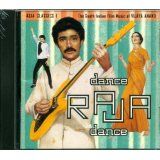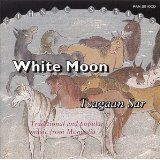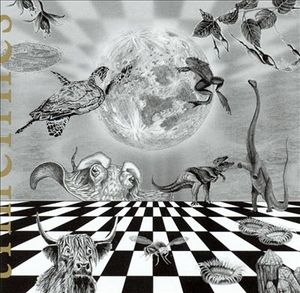 Sect of Phoenix: The Animal Book
Sect of Phoenix: The Animal Book
When Sect of Phoenix’s Wadim Dicke gave me an advance copy of The Animal Book, he voiced his hope that I’d enjoy this specimen of “difficult listening.” After a lifetime spent listening to music that can clear a roomful of people more quickly than a fire threat, I was definitely up for the challenge; however, The Animal Book posed an even greater test to these ears because the spoken-word narratives that are the album’s unifying thread are entirely in Russian, a language of which I can understand perhaps three words. But while I can’t interpret the music through the words, the total effect when combined with the music is powerful indeed.
I’ve always disliked the phrase ‘not for the faint of heart’ when used to describe challenging music, with its implication of unpleasantness; far better to say, ‘for the strong of heart,’ since for those with the fortitude to take the plunge, a record like The Animal Book can be a cathartic experience. This is music that seizes the listener by the lapels and demands to be heard — no polite avoidance possible here. It’s unsettling in the best way in that it defies the listener’s complacency. In its most roiling passages, The Animal Book generates a centripetal force akin to a sonic whirlpool from which there is no escape.
I can only guess at the import of the lyrics by drawing inferences from their musical settings, which give the strong impression that the two speakers, Max Evstropov and Stepan Kachalin, aren’t talking about butterflies and fleecy lambs. The recitation conveys an overpowering sense of alienation and dread to these ears, but of course I could be wrong.
The musical element is appropriately harrowing, and it’s often impossible to determine the sources of sounds due to the heavy processing involved. There is very little ‘playing’ in the normal sense; instead, the listener is confronted with sonic polygons, textural planes, and electrostatic irruptions reminiscent of some kind of musical Wimshurst machine.
In album opener “Flowers of the Base,” an opening soliloquy is gradually enveloped in dense microtonal clouds that suggest the atmosphere of Jupiter. The titular piece at first elicits images of volcanic steam vents, soon supplanted by Dicke’s leviathan bass drones and a wrenching ‘solo’ that sounds like it was played on guitar but is actually processed bass, with Evstropov insistently intoning cryptic syllabic refrains all the while; an almost funky interlude follows, then howling chaos. The aptly titled instrumental “The Sky Slips under the Ground That Slips under the Feet” suggests a walk through a garden of jagged glass stalagmites in J.G. Ballard’s Crystal World. “The Womb Ship” summons impressions of distant detonations, the footsteps of approaching ogres, and the sound of oxygen being sucked out of a breach in a spacecraft’s hull, all filtered through an enveloping amniotic fluid. The most ‘song’-like track of the collection is the closing piece, “The Way Things Go”, in which the vocal sounds more like a chant or incantation, underlain by Dicke’s marrow-shaking doomsday bass and frosted by guitar outbursts from Yuri Turov that conjure images of an electrocuted pterodactyl.
Immersing oneself in the sonic cauldron that is The Animal Book is like embarking on a perilous yet ultimately transformational journey where the rewards exceed the considerable risks. Highly recommended for the strong of heart.
Disclaimer: The author is an occasional musical collaborator with members of Sect of Phoenix.
Editorial Reviews for Amazon.com
 Vijaya Anand: Dance Raja Dance: Asia Classics, Vol. 1
Vijaya Anand: Dance Raja Dance: Asia Classics, Vol. 1Before the current vogue for mix-n-match stylistic pastiche, there was the gleefully schizophrenic cinema music of India’s “Bollywood,” here represented by prolific South Indian soundtrack composer Vijaya Anand. In Anand’s crazy-quilt musical cosmos, Indian music cohabits with surf guitar, cheap sci-fi synthesizer effects, saucy brass, dance beats, syrupy strings, and snatches of Arabic, Spanish, and other world musics—but with none of the arch postmodern irony of cut-and-paste artists like John Zorn. Anand’s soundtrack music unselfconsciously references the Spaghetti Western stylings of Ennio Morricone, Vegas lounge kitsch, synthetic Eurodisco, and his own South Indian roots, sometimes within the span of single tune. The occasional tabla break or soaring Kannada-language vocals notwithstanding, Anand’s soundtracks are ultimately more global than Asian, yet somehow this music could only spring from a society of multiple identities like modern India.
 Gyorgy Ligeti: György Ligeti Edition 5: Mechanical Music
Gyorgy Ligeti: György Ligeti Edition 5: Mechanical MusicAlthough Gyorgy Ligeti is best known for his eerie, tonally ambiguous choral and orchestral writing (immortalized in 2001: A Space Odyssey), this collection of works for musical automata—player piano, barrel organ, and metronomes—includes some of his most astonishing music. The player piano pieces are an exhilarating, intensely physical roller-coaster ride through superhuman tempi and dynamic extremes—an intriguing marriage of artifice and human invention. While clearly indebted to the influence of Conlon Nancarrow, Ligeti’s player piano works are more approachable than Nancarrow’s rigorous etudes, revealing the sense of humor that distinguishes Ligeti from his more ponderous contemporaries. Likewise, the controversial prank piece "Metronomes" foreshadows the phasing experiments of Steve Reich with its intricate cross-rhythms created by metronomes marking time simultaneously at different speeds. Perhaps most fascinating of all are Ligeti’s compositions for computer-modified barrel organ—a hand-cranked, calliope-like instrument popular with itinerant musicians in the 1700s.
 Idjah Hadidjah: Tonggeret
Idjah Hadidjah: TonggeretTongerret showcases the sinuous, melismatic female vocals of Indonesia's Idjah Hadidjah, who performs songs spanning three genres of regional Sundanese popular music: the concert music styles kliningan and celempungan, and the dance music jaipongan. The latter style, adapted by renowned composer/choreographer Gugum Gumbira from the earlier, “disreputable” Ketuk Tilu tradition of Sundanese dance music, enjoyed immense popularity throughout Indonesia in the late 1970s and early 1980s, catapulting Idjah Hadidjah to national stardom. Although jaipongan music shares instrumentation (gongs and metallophones) and certain formal similarities with Indonesia's better-known gamelan (ceremonial percussion orchestra) tradition, its forceful drumming and erotic overtones give it a much more contemporary sound. The kliningan and celempungan selections, by contrast, are imbued with a dreamy, soft-focus quality, heightened by Hadidjah’s richly ornamented vocalizing.
 Sinawi Music of Korea
Sinawi Music of KoreaKorean sinawi music originally accompanied propitiatory rites presided over by a female shaman, or mudang. The word sinawi is also synonymous with musical improvisation based on various rhythmic and melodic devices—the most important characteristic of this genre. This collection of sinawi-derived pieces, performed by groups of varying size and instrumentation, evokes the otherworldly sonic space of the shamanistic spirit realm. The opening “Sinawi Ensemble” contrasts full-throated female vocals with the pinched, nasal keening of the double-reed piri and the two-stringed fiddle haegum, gradually building in speed and intensity. In “Haegum-sanjo,” haegum virtuoso Choe Tae-hyon plays like a man possessed, etching jagged melodic flights with exaggerated vibrato and an almost violent bowing technique. “Piri-sinawi” is a brilliant exposition of the timbral peculiarities of the oboe-like piri, conjuring associations as disparate as Scottish bagpipe music and the plunger acrobatics of trombonist “Tricky Sam” Nanton.
 Tsagaan Star
Tsagaan StarThis collection of two dozen brief vocal and instrumental works offers a wide-ranging overview of various Mongolian song forms. Traditional genres represented on this disc include love songs, epics recounting legends and historical events, and songs of praise for Mongolia’s beloved horses and landscape. The music reflects the traditional nomadic lifestyle of the Mongolian people, and is strongly evocative of the country’s windswept steppes and the broad expanses of the Gobi. Indeed, the rhythms of many of these songs bear a striking resemblance to galloping hooves on the grasslands. As in neighboring Tuva, several pieces are performed in the khoomei style of overtone singing, where vocal manipulation enables a singer to produce two tones simultaneously—a deep drone ornamented by a movable series of overtones. The CD booklet provides lyric translations and informative liner notes discussing Mongolia’s music, land, culture, and history.
 Iannis Xenakis: Kraanerg
Iannis Xenakis: KraanergIannis Xenakis is the compleat 20th-century composer—a pioneer of orchestral, electronic, tape, and computer music. His combined background as a musician, mathematician, and architect led to his conception of “Stochastic music,” or composition based on the mathematics of probabilities. As impenetrable as this concept may appear on paper, the music itself packs a visceral and emotional punch that belies its arcane theoretical underpinnings. Now in his 70s, Xenakis is enjoying a golden age, as a new generation of admirers rises to the challenge of performing his demanding works. Leading this resurgence is Zacharie Bornstein’s ST-X Ensemble, who here navigate the long-form electroacoustic work "Kraanerg." Typically, "Kraanerg" is not about melody and harmony so much as the relationships between shifting constellations of pure sound. The presence of youthful sonic frontiersman Paul D. Miller (a.k.a. DJ Spooky) on electronics fittingly brings the composer’s far-reaching influence full circle.

Liner Notes, Timelines by Lesli Dalaba (Tzadik TZ 7713)
Timelines is a singularly audacious undertaking. Over the course of three 15-minute guided improvisations, Lesli Dalaba and her elite corps of improvisers set out to create a sonic representation of not merely a portion of Earth’s history, but all of it, from the first wisps of gases coalescing in the cold void 5 billion years ago, to the teeming cultural Babel of our present century.
As the much-heralded millennial celebrations neared in 1999, Lesli found herself reflecting on the significance of a scant 2,000 years, both in human history and in the grand scheme of terrestrial history. What began in casual rumination grew into a preoccupation that eventually bore fruit in Timelines, her most striking and ambitious project to date.
Not content to rely on vague aural impressionism, Lesli organized the three pieces on this recording around meticulously plotted timelines based on months of exhaustive research of geophysical and archaeological data. The event charts provided here as a listening guide represent only a fraction of the detail found in her scores, which map musical gestures to actual cosmic, geological, biological, and cultural occurrences. Along the way, the listener hears musical depictions of the formation of planetary orbs, shifts in the Earth’s geomagnetic polarity, cycles of freezing and thawing, milestones in the evolution of organic life, mass extinctions and other cataclysmic events, and the development of human language, culture, and technology. Throughout it all, the musicians demonstrate exceptional sensitivity to the challenging subject material, delivering uncanny acoustic and electronic evocations of richly varied historical phenomena.
Each of the three compositions successively narrows in temporal scope. The first timeline, “From the Birth of the Sun,” covers fully 5 billion years of history, from the creation of the Earth as a result of natural forces to the most recent ice age. In Lesli’s interpretation, the signal event in this continuum is the appearance of the earliest life forms – anaerobic bacteria – setting the stage for the evolution of our own species. Another key motif here is the formation of the oceans as the planet solidifies, providing the crucible for an increasing variety of living organisms.
The self-explanatory second timeline, “Dinosaurs to Mammals,” is punctuated by periodic reversals of the Earth’s geomagnetic field (represented by two alternating violin sounds calculated to tenths of a second), a series of dramatic, large-scale extinctions, and the advance and retreat of vast, earth-sculpting ice sheets. During this period, geological forces reshaped the former supercontinent of Gondwanaland into the land masses we recognize today. Our earliest known ancestor, Australopithecus, emerges in the final minute of the piece, which culminates in the first utilization of tools by hominids at the dawn of the Stone Age.
The final selection, “Homo Sapiens Sapiens,” zooms in on the relatively brief history of our own kind as we gradually disperse from Africa across the globe and master the technologies that have proved both a blessing and a curse.
From the composer: “How long is 2,000 years in the context of the entire history of our species? I was surprised to learn that 100,000 years ago, humans identical to ourselves lived in stone and wood huts with indoor fire and refined tools. The earliest permanent villages, with advanced culture, technology, trade, and religion, evolved around 14,000 years ago in the Fertile Crescent, the area we are currently devastating. Our present calendar implies that our story began a mere 2,000 years ago, denying 85 percent of our past civilizations. This denial makes it easier for us to turn a blind eye and allow the destruction, in the Middle East, of our own rich past.”
Among the phenomena sonically portrayed in this timeline are the first tentative steps toward language and toward the worshipping of human images, both represented by interpretations of what is said to be the oldest extant piece of written music, a 3,400-year-old fragment unearthed in Syria. After a manic burst of human activity in the piece’s final minute, Timelines concludes with a repeated distress signal, a cry of concern over the grave impasse at which our species has arrived in our time.
Reviews for The Improvisor
Lol Coxhill & Veryan Weston: Boundless
On this disc, the longstanding duo of Lol Coxhill and Veryan Weston largely forgo the atomised abstractions favoured by many of their peers on the British free improv front, instead engaging in playful, conversational discourse that skirts the edges of idiomatic play. Where many of their contemporaries studiously avoid even fleeting references to established genres, the Coxhill/Weston duo at times veer into not-quite-jazz, submerged blues, and tipsy melodies, not surprising given Coxhill’s history of involvement in jazz, progressive rock, and theater.
The soprano/piano pairing inevitably invites comparison to Steve Lacy and Misha Mengelberg’s meetings, though Coxhill’s phrasing is much less measured, and his tone far more tart and astringent, than Lacy’s. Coxhill has long been the quintessential British eccentric, and despite the liner note’s claim that “there is virtually no overt humour here,” even at its most rarefied the music possesses a (not inappropriate) comic element.
Since their first recorded meeting in 1978, Weston and Coxhill have developed an empathy bordering on the telepathic, each shadowing or anticipating the other’s moves with uncanny perspicacity. In the course of fifteen concise improvisations ranging from one to six minutes in length, the duo cover wide tracts of musical territory, engaging in nimble rabbit chases, slippery lyricism, brittle pointillism, and more. Though rarely straying into anything resembling conventional tonality, the players tend to improvise with notes rather than with raw sound, the odd whirr, hiss, and rumble notwithstanding. All in all, an exemplary demonstration of the art of the duo.”
Takla Makan with Barre Phillips Though previously unaware of the three principals on this CD, I was immediately intrigued by its "theme," the austere Takla Makan desert of Chinese Turkestan. Titles such as "Sven Hedin" (an early explorer of the region) and "Lop Nor" (a vanishing inland sea used as a nuclear testing ground by the Chinese) tempt the listener to hear this disc in programmatic terms, but there's little to suggest the parched landscapes of the Silk Road in the trio's wide-ranging, non-idiomatic improvisations.
In a curious irony, the CD includes liner notes questioning the validity of recording and releasing improvised music in the first place. Having set themselves this challenge, the trio go on to refute the argument admirably with mature, impeccably executed extemporizations. The members of Takla Makan have been working together since 1993, and here present pieces recorded in 1994, '95, and '96 with various guest collaborators. Each session was "directed" by one of the participants, who provided instruction (or no instruction) as he deemed fit. The presence of perennially underrated bassist Barre Phillips looms especially large on this disc, introducing darker colors and greater textural variety into the trio's relatively bright, narrow tonal signature.
Takla Makan and its guests generate a great deal of variety across the CD, with passages ranging from carefully placed sound events to hyperkinetic flights fueled by the propulsive drumming of Filippo Monico. A finely detailed, well-balanced set of excursions by a group of players we'll surely be hearing more from.
 Sect of Phoenix: The Animal Book
Sect of Phoenix: The Animal Book Vijaya Anand: Dance Raja Dance: Asia Classics, Vol. 1
Vijaya Anand: Dance Raja Dance: Asia Classics, Vol. 1 Gyorgy Ligeti: György Ligeti Edition 5: Mechanical Music
Gyorgy Ligeti: György Ligeti Edition 5: Mechanical Music Idjah Hadidjah: Tonggeret
Idjah Hadidjah: Tonggeret Sinawi Music of Korea
Sinawi Music of Korea Tsagaan Star
Tsagaan Star Iannis Xenakis: Kraanerg
Iannis Xenakis: Kraanerg
